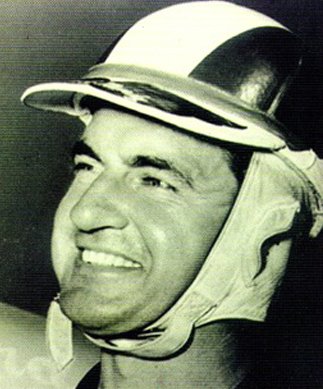
Frank "Rebel" Mundy was a driver to be reckoned with in the 1950s.
By Preston Stevens-Guest Contributor
Posted in Feature Stories 11/5/10
Born in Atlanta, Georgia as Francisco Eduardo Menendez, Frank “Rebel” Mundy is a legend in the ranks of Georgia’s racing history.
His Spanish father worked in Atlanta, but died when Frank was quite young. He was sent to an orphanage and it was there that he learned the strong work ethic and fearlessness, which served him well his entire life.
Delivering parcels led to motorcycles, which led to stunt driving. He performed 2,200 shows at the 1939 and 1940 New York World’s Fair. His specialty was the “Slide For Life”, in which he was towed at high speeds through fire while wrapped in asbestos – scrub the theory about asbestos shortening your life!
Frank met Bill France, Sr. at France’s Gas Station in Daytona Beach, Florida. He and France, along with several others, founded NASCAR in 1947. Mundy finished 30th in the first NASCAR race at Charlotte, NC on July 19, 1949. In the second race, he came home third at Daytona Beach.

Frank Mundy (left) and car owner Perry Smith (right) with their victorious Studebaker in 1951.
Mundy caught quite a bit of attention in 1951 when he competed in 25 events piloting a Studebaker in 24 races for owner Perry Smith. He recorded two victories that year in the Studebaker, at Columbia, South Carolina on June 16 and at Mobile, Alabama on November 25. He won both events from the pole. He also piloted an Oldsmobile to victory at Martinsville, driving for fellow Georgia Racing Hall of Fame member Ted Chester.
But Mundy raced the car he was most famous for halfway through 1952, when he competed in a Hudson Hornet in a NASCAR Grand National event at the Michigan State Fairgrounds on June 29. He finished 11th in a Hornet owned by Walt Chapman.
It marked the beginning of a beautiful friendship between Mundy and Hudson, and the departure of the Atlanta Driver from NASCAR for the ne next four years.
Mundy left Bill France’s empire to compete on the AAA Stock Car circuit. He piloted his Hudson to one win in 1952 at Carrell Speedway in Gardena, California on Dec. 7, leading 142 laps en route. He would record five wins in 1953, including two wins at Carrell, one at Toledo, one at Heidelberg Speedway in Pennsylvania and a victory at the Milwaukee Mile.
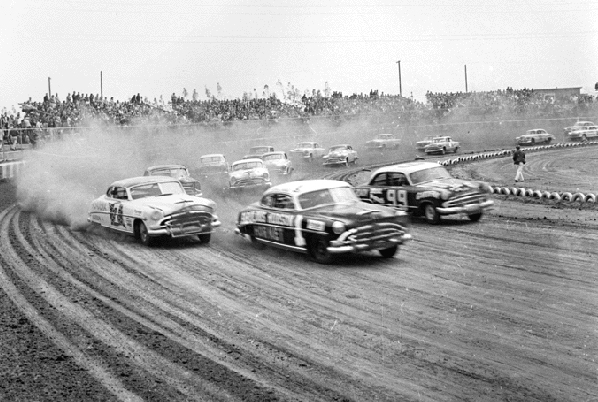
Mundy (7) battles fellow Hudson pilot Marshall Teague (1) in AAA action at Carrell Speedway in Gardna, California.
Mundy’s final win in a Hudson came at Broadway Speedway in Knoxville, Tennessee, in a 1954 Hudson.
After one last race at Milwaukee in his Hudson, where he finished 10th, Mundy became a driver for Carl Kiekhaefer, who would soon be taking NASCAR by storm.
Mundy piloted Kiekhaefer’s AAA Chrysler to a victory his first time out, winning again at Knoxville. Mundy would tag on two additional wins for Kiekhaefer, winning back-to-back events at the Milwaukee Mile.
In 1955, Mundy would pick up eight AAA stock car wins driving for Kiekhaefer, including a run of five in a row, and was the series champion as a result.
Mundy would return to NASCAR in 1956, driving select Grand National and Convertible events for Kiekhaefer. He recorded six wins in his pop-top 1956 Dodge, including the final win of his career at the Missouri State Fairgrounds on June 17.
After 1956, Frank “Rebel” Mundy hung up his helmet, and went to work for Kiekhaefer at Mercury Outboard Motors and stayed there for 17 years.
Throughout his life, Frank was an entrepreneur in real estate, among other things. In one bold venture, he bought a fledgling boat operation and turned it into the million-dollar Custom Craft Boats Co.
The Mundys lived in a world of skiing, yachting and following the Indy Car circuit with his friend Roger Penske and the Penske Racing Team. The Mundy’s car collection included a 1967 Lamborghini V-12, a Lincoln, a Cadillac Eldorado convertible and a Rolls Royce.
At the time that this interview was conducted in 1998, they did not own a Hudson Hornet. We planned to work on that.
—
This interview came about after reading a reprint in the Nov./Dec. 1997 issue of the White Triangle News of an article from the February, 1954 Auto Age magazine featuring my neighbor Frank “Rebel” Mundy. Realizing I had not seen Mundy for a long time, I armed myself with a tape recorder and a camera and headed over to the next street in my 1953 Hudson Hornet.
Preston: Frank, we have both lived in Atlanta all our lives, but have rarely seen each other. So today I took advantage of the fact that we are neighbors and climbed into my ’53 Hudson for a visit. You have kindly consented to let me take pictures and hear some racing lore. I’d like to follow up on a reprint of the 1954 Auto Age article called…
Frank: “I Drive Stock Cars”.
Preston: And you sure did! Now, before we sat down, you were telling me about the mechanic pictured in that article and the problem he caused for you.

Frank "Rebel" Mundy poses with his highly successfull Hudson Hornet.
Frank: In towing a Hudson to Indiana, we jackknifed and knocked the front-end alignment out, and when he put it back, he left out the lock washer from under the steering wheel. I started a hundred mile race last and finally, about 40 or 50 laps later, got into the lead and going into number two turn the steering wheel came off in my hand. I went through two fences into five parked cars. Fred Wheat was his name. He was a tremendous mechanic, but we just couldn’t get him to be on time for anything. Naturally, I let him go that night. It kept building up, but that was the last straw.
Preston: He is pictured in that White Triangle article.
Frank: That’s right. He has my name on the back of his jacket. The next day I finished second without a mechanic.
Preston: You are soon headed for Daytona for a get-together.
Frank: Yes, the annual race. The Living Legends of Auto Racing have an annual banquet open to the public. On Tuesday, Feb. 10, we have a parade on Daytona Beach. On Friday we will ride around the track – we’ll have our names on the cars. Tim Flock will be there and Herb Thomas.
Preston: These were Hudson drivers. How about Dick Rathmann?
Frank: Rathmann doesn’t seem to come up to it. This will be our fifth year.
Preston: You remember several years ago we had Herb Thomas, Tim Flock and you at our Chapter meeting. Also, Johnny Allen and Louise Smith all together.
Frank: Louise won’t come down this time. She’s usually there. She’ll be there next year.
Preston: You seem to be in very good condition. The old Hudson drivers are hanging in there. Some have not been so lucky, such as Frank Luptow.
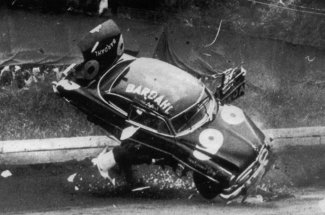
This crash at Lakewood Speedway in Atlanta in 1952 took the life of Frank Luptow. Mundy was right behind Luptow when the crash occured in the track's first turn. Photo courtesy Eddie Samples
Frank: I have been very fortunate. I usually work out about five days a week. You asked me about Hudson driver Frankie Luptow and the incident that happened at Lakewood Speedway in Atlanta. It’s a mile dirt track with the longest straightaway and the sharpest left turn you’ll ever find. That would be the south turn. The night before we had a party at our house and Frankie and Marshall Teague came over with their families. He was telling me he had kind of an arm extension that he put on his right rear axle and if the axle should break, it would act as a skid. With that low center of gravity and that outer beam, the wheel can’t come out of the wheel well and it would start flipping the car. Next day there was a little run going into the number one turn. Marshall Teague was leading, I was running third and Frankie was running second. Just before I would get to that rut each time I would back off, but he felt assured he had it licked and he flipped right in front of me. I almost went into the infield lake. The car showed a dent in the top of the car where it came down on top of him.
Preston: I have the old newspaper photo that shows him and the car in mid-air – his door is open. The trunk is open and the hood is open. That Hudson is just spinning in the air and, as you said, it came down on top of him and he was gone.
Frank: That’s right, his confidence was up, but we had a fellow named (Harold) Morse killed in Gardena, California just two weeks before. In fact, that year we had about three killed due to that axel problem in Hudsons.
Preston: All three of you – Marshall, Frank and you were kind of neck and neck in that trace.
Frank: And Dick Rathmann, too.
Preston: Did the Hudsons have a tendency to break?
Frank: The factory got behind it and corrected it, but it took – I know of three of them that were killed. I was in the race in Gardena when Morse was killed – in fact, I won that race with a Hudson. Marshall had one break on him in that race. It didn’t throw him out, but it did tear up the car.
Preston: It’s well known that you drove Studebakers for a time.

Mundy sat on the pole for the 1951 Southern 500 at Darlington in his Studebaker, but went out early due to mechanical issues.
Frank: That’s because the car owner was a Studebaker dealer in South Carolina and the car was well balanced.
Preston: Didn’t Curtis Turner drive Studebakers?
Frank: No, he drove mostly Hudsons and Olds. Quite frankly, I think Curtis Turner was the most natural and the hardest driver I ever ran against. If he’d get ahead of me, I’d have trouble catching him.
Preston: Curtis had a reputation for bending the rules…
Frank: yes, in fact at North Wilkesboro, a modified race, I’m on the outside and he takes me into the fence, and I go outside. I walk back to the center o the track and pick up gravel and rocks. Every time he comes by I throw it into his windshield. His crew came down and beat the devil out of me.
Preston: It was just a game with him wasn’t it – he never held a grudge, did he?
Frank: No, he never held a grudge and I didn’t either. He flew a plane and they took his license a couple of times. He and I and Bill France flew our own planes.
Preston: Getting back to the AAA, I’d like to hear more about your championship years. I presume ’53 was in Hudsons.
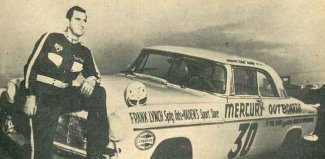
Mundy piloted a Chrysler for Carl Kiekhaefer in AAA, winning the 1955 AAA championship in the process.
Frank: That’s right and in ’55 was in the Chrysler 300. I went to 3-A because Bill France and I had a disagreement. Somebody said I was burning methanol instead of gasoline. France said to leave the car keys in the office for him to look into it. The next day I went up and asked them what they did find and they said I did not have the spare tire in the trunk, but it was for fear it would fly out and kill somebody, and therefore I was disqualified as not being stock. I sold my car that day. They just wanted Tom McCahill, the auto writer, to get the speed record.
Preston: You and France worked to start NASCAR and were friends.
Frank: We were very close and I don’t think he did it maliciously. But I told him I wouldn’t kiss his ass!
Preston: Can you tell us something of the ’53 year for the AAA as it pertains to Hudson? I assume you drove a new ’53 Hudson.
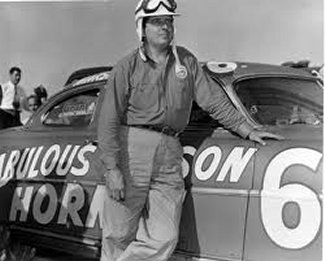
Florida racer Marshall Teague is generally ackowledged as the man who brought Hudson into stock car racing.
Frank: The only competition that was close to being competition was the Olds 88. Jim Rathmann, Jack McGrath and Marshall Teague were the top competitors. Marshall as one of the toughest drivers, but he would even help me work on my Hudson – he was a master mechanic – knowing it might even wind up beating him. One of the nicest guys ever in racing.
Preston: He was the man I believe that convinced Hudson to get into stock car racing.
Frank: That’s right, Marshall had a garage in Daytona and it was mainly through Marshall the factory got involved.
Preston: How about Smokey Yunick, he had a garage in Daytona also. About 15 years ago we drove that black Hudson (that) I drove here down to Daytona and showed it to Smokey. He looked all over it. He had some Hudson engines there.
Frank: Anytime Smokey had a car in the race, it was the one to beat. He’s a credit to racing and he’s really ahead of everybody else it seems.
Preston: Do you have any comments about any other drivers?
Frank: Tim Flock was a real fine, steady driver – all of the Flocks where – Bob and Fonty.
Preston: Fonty was a real charmer. I understand he was quite a ladies’ man.
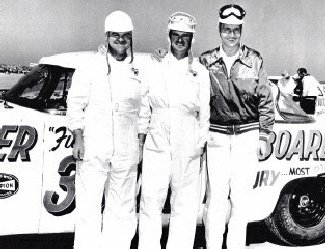
Fonty Flock, Frank "Rebel" Mundy and Tim Flock as Kiekhaefer team mates at Daytona in 1956. All three are now members of the Georgia Racing Hall of Fame. Photo courtesy Frances Flock
Frank: Yes, he was at North Wilkesboro and some fellow came up and Fonty had the flashy smile and white teeth and Fonty thought he wanted his autograph, and instead this guy hauled off and hit him right in the jaw. He’d been running around with the guy’s wife!
Preston: You recall in 1985 we had our National Hudson Convention in Atlanta and although you and Tim couldn’t come, we did get Dick Rathmann to come and give our keynote speech and he did a good job.
Frank: He was not only a good driver, but a heck of a nice guy.
Preston: At that convention we drove our cars around the old Lakewood track.
Frank: I was in a modified race there when the dust was so bad I couldn’t see. I gave the wheel one twist to the left and that’s the last thing I remember. I woke up one block from the hospital in the ambulance. The post right beside my head knocked me out and knocked my shoes off. My wife followed the ambulance and I got out and ran back to the car my wife was in and I got back to the track. I borrowed a car and ran in the feature and got second. I dove barefooted – I never did find my shoes.
Preston: Poor Mae, she has been long suffering. How long have you been married?
Frank: How long, Mae?
Mae: 1945.
Frank: I’m in the Air Force in Alpine, Texas, instructing twin engine Cessna VC78B and I had a weekend off and they had a cattle auction about 20 miles away and I saw her, I liked her and I bought her.
Mae: It’s true – my dad had a cattle barn.
Preston: What was it like for you, waiting during those races?
Mae: You just have confidence it isn’t going to happen to you – he’s too good! He can handle it, but he broke his leg twice snow skiing!
Frank: I think when a person gets my age – I’m about 80 years old – you shouldn’t take a chance skiing anymore; it may not be your fault, but could be somebody else’s.
Preston: You are in great shape for a person 80 years old. Can you tell us why so many drivers raced Hudsons in the years ’51 through ’54?
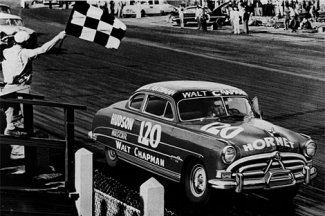
Dick Rathmann picks up another win for Hudson. The Hornets proved to be so volatile on the race track that NASCAR instituted new rules to limit how many of the racers could be entered in a single event.
Frank: Well, at that time if you didn’t have a Hudson, the odds of you winning a race were very slim. The car was fast, it was streamlined, the low center of gravity – if you didn’t have a Hudson, you were just not likely to do any good. The Olds 88 could stay with us possibly on the straightaway, but the Hudson went through the turns a great deal better and more equally stabilized. The Olds had a tendency to lean in the turns.
Preston: Have you had many interviews after your racing career was over?
Frank: We had a number of them come by and they’ve put it in magazines and newspapers. Three years ago they did about five pages in each issue of the Winston Cup Magazine, a racing publication out of Charlotte, North Carolina.
Preston: You also got me the February issue of Stock Car Racing Magazine, which has a feature article on you, and Mae has just brought me these two Winston Cup Magazines. Its no surprise to me that people still remember and come and seek you out.
Frank: There’s the Hudson at Gardena, California…
Preston: And Johnny Mantz driving a Nash.
Frank: That’s me with the rebel flag on the Hudson.
Preston: Did Mantz do well in the Nash against your Hudson?
Frank: Yeah, but I’m lapping him there! Speaking of Nash, Bill France was trying to get the factory into racing. So France and I and Marshall and his wife fly out to Gardena. I get there on a Friday and tell the Nash fellow I want to try the car and tells me the factory called and said they couldn’t let me drive it because it was not to be introduced to the public until the next week – a big mistake was made. So the morning of the race I told France to drop me off at Hertz U Drive It and I get a Plymouth coupe. Went and got white-wash and put an “X” on the car, taped the headlights, put a seat belt in it and stayed out of everybody’s way and finished about 10th. I took it back hat night. The fellow looked at it, didn’t see any dents. When he saw the front tires, he said, “Damn, those tires are smooth.” Without cracking a smile, I said, “Yeah, it must be out of alignment.” I got about $85 in that race.
Preston: It was pretty good for a Plymouth.
Frank: It got to be that there were so many people driving Hudsons, they made a rule limiting each make of car to only four cars, the fastest four got in the race.
Preston: Otherwise, Hudson would have dominated…
Frank: yes, so they made that rule for Hudson. In Darlington they accepted 82 cars and 120 wanted to get in. It was the one way to get some other cars in. Otherwise, they’d have had 20 or 30 Hudsons!
Preston: The stock car races I’ve seen recently, they’re not really stock…
Frank: I don’t think they were too stock when we were running. We got away with what we could. That’s a misnomer, “stock”.
Preston: And yet you did drive one right out of the showroom and placed in the money.
Frank: You know the definition of a race driver: You have to be took lazy to work, too much of a coward to steal and braver than Dick Tracy!
Preston: I sure appreciate you being able to see me today. I’d like to place this tape in the files of the Hudson-Essex-Terraplane Historical Society. I’m sure it would be a valuable addition. Also, I’m going to make this available to the crew that’s making our video in hopes a “sound bite” can get into that.

Mundy wrapped up his racing career in 1956 driving for Carl Kiekhaefer on NASCAR's convertible circuit.
Frank: The people from ESPN came by about a month ago and sometime in February something’s going to be on ESPN. They interviewed me and Tim, Herb Thomas and Louise Smith and other drivers. Also Buck Baker.
Preston: There were other lesser-known Hudson drivers such as Arden Mounts and Jesse James Taylor. Do you know if they are still living and do you see them?
Frank: I haven’t kept up with them. I also remember Slick Smith, Buddy Shuman and Glenn Dunaway.
Preston: When I went out to Lakewood in the 40s, the big names were Roy Hall, Lloyd Seay, Legs Law and Gober Sosebee.
Frank: I remember them well. Roy and Lloyd were bootleggers primarily. Roy died about 10 years ago. Legs was in the numbers racket, but Gober was also a farmer. He was killed on a tractor just a day after I was with him. But the main Hudson drivers were me, Herb, Tim, Dick and Marshall.
Preston: It’s interesting that all those drivers were from the southeast and all the Hudson drivers except Marshall are very much alive and active racing enthusiasts – especially you!
The interview ended and Frank proceeded to his health club for his daily workout!
Editor’s note: This interview occurred sometime in early 1998, and was most recently published in the July/August 2009 issue of the White Triangle News, the National Hudson publication. Frank Mundy was inducted into the Georgia Racing Hall of Fame in October of 2003. He passed away on May 15, 2009 at the age of 91.
Preston Stevens is a lifelong fan of the Hudson Motor Company, and a keen observer of Georgia automotive history. A retired architect, Stevens was a frequent contributing editor to Car Collecting Magazine in the eighties and nineties, and has also authored numerous articles in architectural and design journals in the seventies and eighties. He currently serves as the Associate Editor of Hudsonews, the newsletter for the Dixie Chapter of the Hudson-Essex-Terraplane Club.
Questions, comments, suggestions? Email us!
This website is not affiliated with or endorsed by the Georgia Racing Hall of Fame or the Georgia Auto Racing Hall of Fame Association, Inc. All content is the intellectual property of the individual authors. All opinions are those of the individual authors. Please do not repost images or text without permission.
